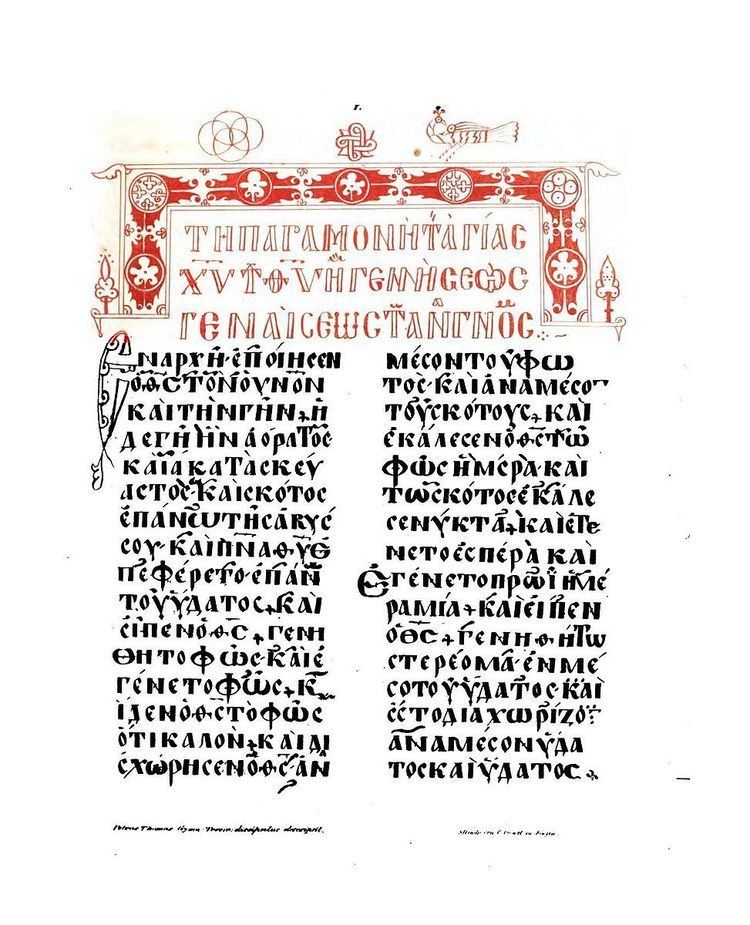Name Codex Sancti Simeonis Size 25.8 by 19.7 cm | Date 10th century Now at Domschatz | |
 | ||
Text Evangelistarion, Apostolarion | ||
Codex Sancti Simeonis, commonly known as Lectionary 179, designated by siglum ℓ 179 in the Gregory-Aland numbering, is a Greek manuscript of readings from the Old and New Testaments, written on parchment. It has been dated to the 10th century but was heavily corrected by a later hand. The manuscript is housed in Trier. It has not survived in complete condition.
Contents
Description
The codex consists mostly of readings from the Old Testament, with some from the Gospels of Matthew, Mark and Luke (Evangelistarion) and the General epistles (Apostolarion), with some gaps. The whole codex is written on 202 sheets of parchment measuring 25.8 cm by 19.7 cm, only eight of which contain New Testament lessons. It also contains some non-biblical material, such as a Menology (hagiography with lives of the saints).
The text is written in Greek uncial letters in two columns of 25 lines to a page. It uses rough and smooth breathings, accents, and stichometrical points, not spaces, between the words. It contains decorated headpieces, decorated initial letters, and musical notes in red in the margin. It has subscriptions at the end of each biblical book with some notes about these books. Itacism occurs frequently, for example: αι and η for ε, ει for ι, ω for ο, υ for οι.
The nomina sacra and other words are written in abbreviated form in the codex. The following words are abbreviated: και (and), πατηρ (father), μητηρ (mother), υιος (son), θυγατηρ (daughter), ανθρωπος (man), Θεος (God), Κυριος (Lord), σωτηρ (saviour), πνευμα (spirit), ουρανος (heaven), Αβρααμ (Abraham), Δαυιδ (David), Χριστος (Christ), Ιερουσαλημ (Jerusalem). These abbreviations in mainly the same as in the Codex Alexandrinus.
The codex has some unusual readings that occur rarely or not at all in other manuscripts. In Genesis 12:4, for example, it has: θεος (God) instead of Κυριος (the Lord). It has many grammatical corrections and marginal notes, giving readings close to the Codex Vaticanus and Codex Alexandrinus.
History
Scrivener and Gregory dated the manuscript to the 10th or 11th century. The Institute for New Testament Textual Research now assigns it to the 10th century on paleographical grounds. It was brought out of Syria in the 11th century. In the subscription is written "Λαβρετιος, ἱερομοναχος σιναιτης, ὁ παλαιολογος, ἐν μηνι δεκεμβριου, κα ᾳφπε", which R. M. Steininger translated as: "Labretius, sacer monachus Sinaita, palaeologus, mense Decembri, die 21. anni MDLXXXV". This means that at the end of the 16th century the manuscript still was located in the East (Sinaita means "of Sianai").
The codex was added to the list of Greek New Testament manuscripts by Scholz. Formerly it was labelled as Lectionary 179e (for Evangelistarion) and 55a (for Apostolarion) by F. H. A. Scrivener and C. R. Gregory. Gregory assigned the single number 179 to it in 1908.
R. M. Steininger produced an edition of the codex with two plates in 1834. Caspar René Gregory saw the manuscript in 1884. It was examined in 1895 by Georg Flügel, who published a description with four plates.
The manuscript is not cited in the UBS3 or UBS4 critical editions of the Greek New Testament. It is held in the Domschatz museum in Trier.
